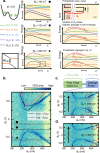Wigner-molecularization-enabled dynamic nuclear polarization
- PMID: 37221217
- PMCID: PMC10205738
- DOI: 10.1038/s41467-023-38649-5
Wigner-molecularization-enabled dynamic nuclear polarization
Abstract
Multielectron semiconductor quantum dots (QDs) provide a novel platform to study the Coulomb interaction-driven, spatially localized electron states of Wigner molecules (WMs). Although Wigner-molecularization has been confirmed by real-space imaging and coherent spectroscopy, the open system dynamics of the strongly correlated states with the environment are not yet well understood. Here, we demonstrate efficient control of spin transfer between an artificial three-electron WM and the nuclear environment in a GaAs double QD. A Landau-Zener sweep-based polarization sequence and low-lying anticrossings of spin multiplet states enabled by Wigner-molecularization are utilized. Combined with coherent control of spin states, we achieve control of magnitude, polarity, and site dependence of the nuclear field. We demonstrate that the same level of control cannot be achieved in the non-interacting regime. Thus, we confirm the spin structure of a WM, paving the way for active control of correlated electron states for application in mesoscopic environment engineering.
© 2023. The Author(s).
Conflict of interest statement
The authors declare no competing interests.
Figures




References
Grants and funding
- 2018R1A2A3075438/National Research Foundation of Korea (NRF)
- 2019M3E4A1080145/National Research Foundation of Korea (NRF)
- 2019R1A5A1027055/National Research Foundation of Korea (NRF)
- 2019M3E4A1080144/National Research Foundation of Korea (NRF)
- RS-2023-00207732/National Research Foundation of Korea (NRF)
- 2023R1A2C2005809/National Research Foundation of Korea (NRF)
- 2019M3E4A1080144/National Research Foundation of Korea (NRF)
- 2019M3E4A1080145/National Research Foundation of Korea (NRF)
- 2019M3E4A1080144/National Research Foundation of Korea (NRF)
- 2019M3E4A1080145/National Research Foundation of Korea (NRF)
- 2019M3E4A1080144/National Research Foundation of Korea (NRF)
- 2019M3E4A1080145/National Research Foundation of Korea (NRF)
- 2019M3E4A1080144/National Research Foundation of Korea (NRF)
- 2019M3E4A1080145/National Research Foundation of Korea (NRF)
- 2019M3E4A1080144/National Research Foundation of Korea (NRF)
- 2019M3E4A1080145/National Research Foundation of Korea (NRF)
- 2019M3E4A1080144/National Research Foundation of Korea (NRF)
- 2019M3E4A1080145/National Research Foundation of Korea (NRF)
- 2021R1A6C101B418/Korea Basic Science Institute (KBSI)
LinkOut - more resources
Full Text Sources

